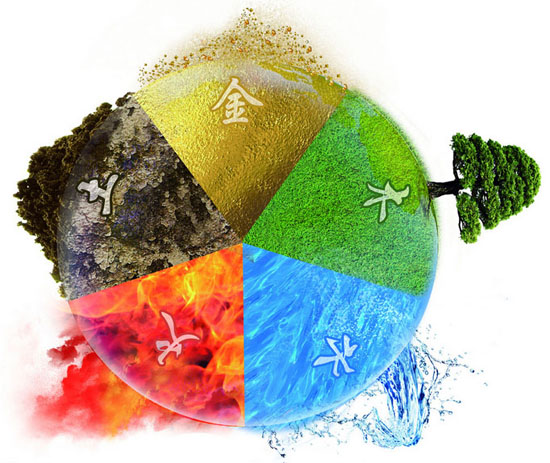In the treatment of disease, the theory of the five elements is mainly used to control the transmission of disease and decide therapeutic principles.
Controlling Transmission of Disease
The pathological changes of the five zang-organs, according to the phenomena of over restraint, reverse restraint and mutual involvement of the mother-element and the child-element among the five elements, can affect and transmit to each other. Thus in clinical treatment of the affected viscus, other viscera to be possibly involved must be taken into consideration by taking preventive measures in advance to control the transmission of disease. However, the following two points have to be borne in mind. One is to select the viscera that are subject to transmission for treatment.
For example, liver disease, according to the theory of five elements, tends to transmit to the heart, the lung, the spleen and the kidney. However, clinically the organ that is more frequently to be affected by liver disease is the spleen. So preventive measures should be taken in advance to protect the spleen in the treatment of liver disease. The other is that the treatment should be done according to the functional state of the viscera.
Though liver disease tends to transmit to the spleen, the transmission usually results from the abnormal changes of spleen function. If the spleen is sufficient in qi, healthy in function and powerful in resistance, liver disease is difficult to transmit to the spleen and no measures need to be taken to deal with the spleen. If the spleen is too weak to resist attack of liver disease, it will be invaded by liver disease. In this case measures must be taken to prevent further transmission in treating the spleen.

Deciding Therapeutic Principles
Visceral diseases, according to the inter-promotion and inter-restraint relationships among the five elements, may affect each other. Clinically the theory of the five elements can be used to readjust the relationships among the five zang-organs to realize the aim of treatment. Usually the therapeutic principles are decided in the light of inter-promotion and inter-restraint relationships.The therapeutic principle decided according to inter-promotion relationship is termed "tonifying the mother-organ and purging the child-organ".
Tonifying the mother-organ is a therapeutic principle used to treat deficiency syndrome. It is also known as "tonifying the mother-organ in the treatment of deficiency syndrome". This principle is mainly used to treat deficiency syndrome due to failure of the mother-organ to promote the child-organ. The aim of this principle is to strengthen the weakened child-organ by tonifying the mother-organ. Take insufficiency of liver-yin for example. Since it results from malnutrition of liver-wood due to insufficiency of kidney-yin, it can be treated by nourishing kidney-yin. Since the kidney is the mother-organ of the liver, tonifying kidney-water can promote liver-wood. That is why this therapy is called "enriching water to nourish wood."
Purging the child-organ is a therapeutic principle used to treat excess syndrome, also known as "purging the child-organ in treating excess syndrome". This principle is mainly used to treat excess syndrome resulting from disorder of the mother-organ by reducing exuberant pathogenic, factors through purging the child-organ. For example, superabundance of heart-fire due to hyperactivity of liver-fire can be treated by purging the heart because the heart is the child-organ of the liver. That is why liver-fire can be reduced by purging heart-fire. The principle decided according to inter-restraint relationship is called "inhibiting the strong organ and supporting the weak organ".
The abnormal states of inter-restraint among the five elements are over restraint and reverse restraint. In visceral disease, the manifestations of such abnormal relationships are signified by a series of pathological changes resulting from visceral imbalance. The principle of inhibiting the strong organ and supporting the weak organ means to correct visceral imbalance and restore visceral harmony in function. Inhibiting the strong organ and supporting the weak organ, two different sides of a therapeutic principle, are closely related to each other.
The purpose of inhibiting the strong organ is to prevent it from bullying the weak organ while the aim of supporting the weak organ is to correct its deficiency so as to free it from the domination of the strong organ. Inhibiting the strong organ and supporting the weak organ can be used singly. However, they are frequently used in combination in order to quickly correct visceral imbalance. For inhibiting the strong organ, purging therapy is usually used; for supporting the weak organ, nourishing therapy is frequently resorted to.
The application of this principle is often marked by simultaneous application of attack and tonification. For example, adverse flow of liver-qi tends to invade the spleen, but deficiency of spleen-qi also makes it easy for liver-qi to attack the spleen. Thus disease resulting from liver-qi attacking the spleen can be treated by inhibiting wood and supporting earth (also known as inhibiting the liver and strengthening the spleen), simultaneously reducing liver-qi and strengthening spleen-qi. With the regulation of both the spleen and the liver, there will be no difficulty in curing spleen disease.







